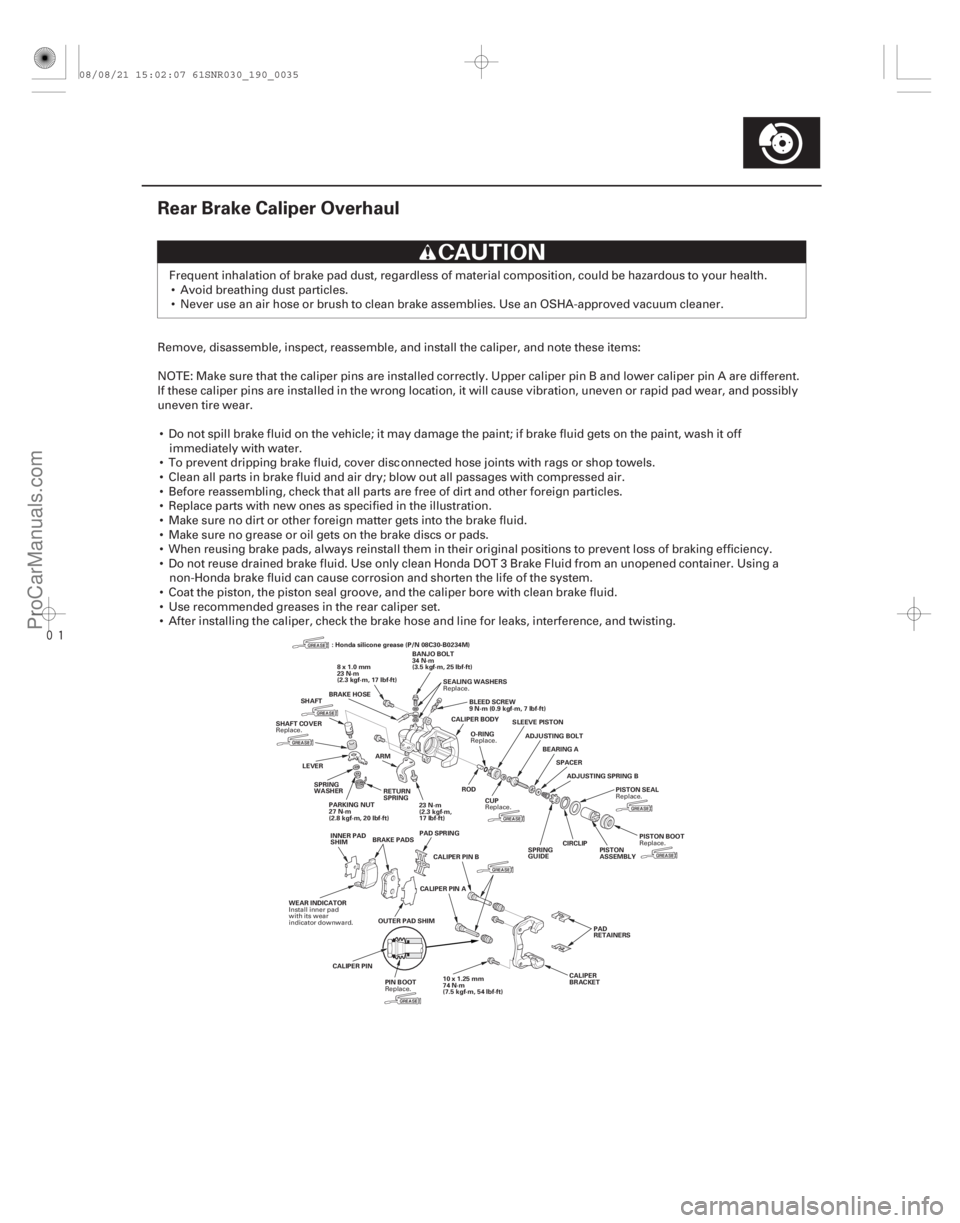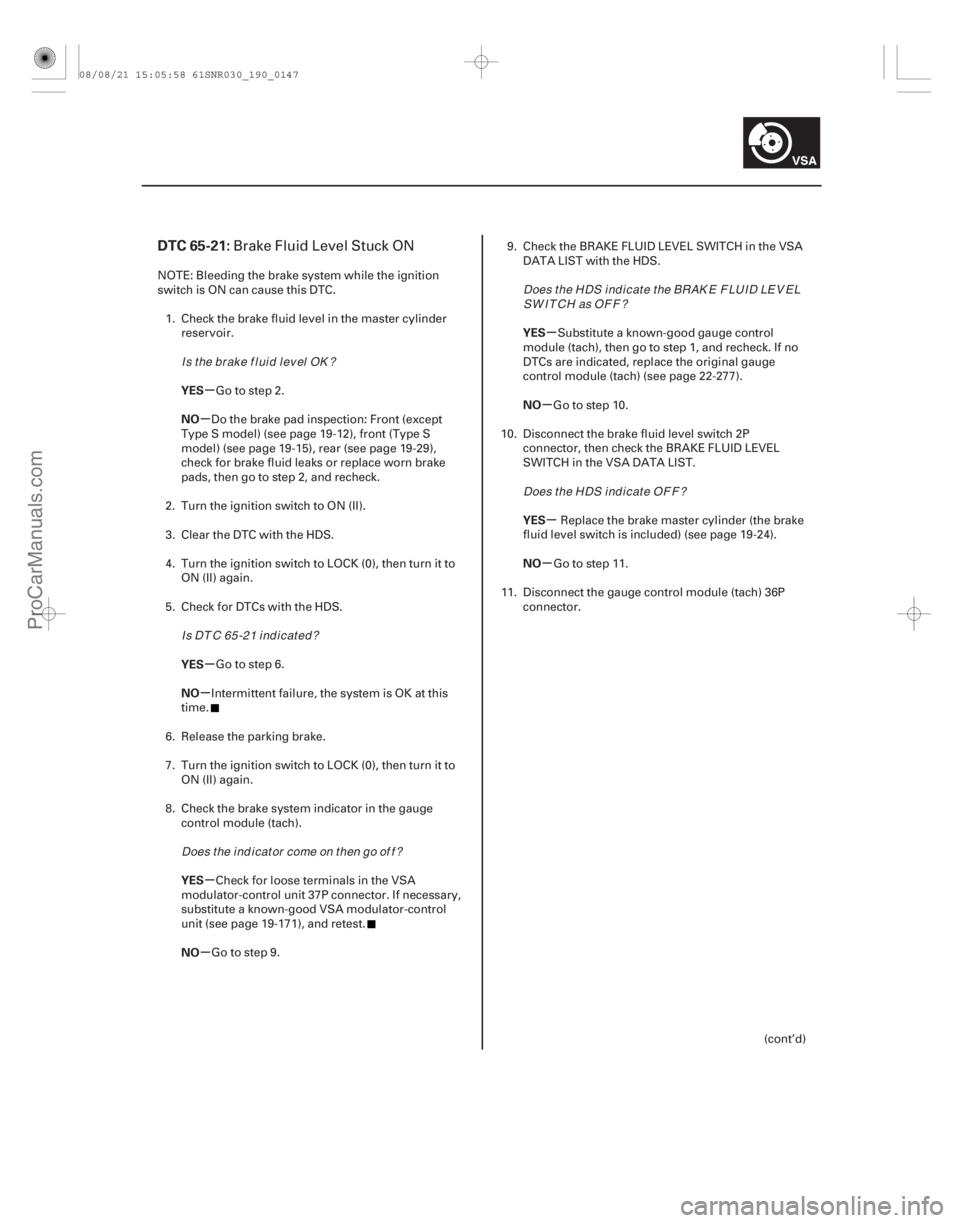Page 1525 of 2893

�����µ
�µ
Thickness and Parallelism
Brake disc thickness: Standard: 8.9 9.1 mm (0.35 0.36 in.)
Max. refinishing limit: 8.0 mm (0.31 in.)
Brake disc parallelism: 0.015 mm (0.0006 in.) max.
19-33
10 mm (0.39 in.)
1. Raise the rear of the vehicle, and support it withsafety stands in the proper locations (see page
1-11).
2. Remove the rear wheels.
3. Remove the brake pads (see page 19-29).
4. Using a micrometer, measure the brake disc thickness at eight points, about 45 ° apart and
10 mm (0.39 in.) in from the outer edge of the brake
disc. Replace the brake disc if the smallest
measurement is less than the max. refinishing limit.
NOTE: This is the maximum allowable difference
between the thickness measurements. 5. If the brake disc is beyond the service limit for
parallelism, refinish the brake disc with a Honda-
approved commercially available on-car brake
lathe.
NOTE: If the brake disc is beyond the service limit
for refinishing, replace it (see page 19-34).
6. Install the brake pads (see page 19-29).
7. Clean the mating surfaces between the brake disc and the inside of the wheel, then install the rear
wheels.
08/08/21 15:02:06 61SNR030_190_0033
ProCarManuals.com
DYNOMITE -2009-
Page 1526 of 2893

����
����
�(�#�'�����������
�����������
�������
� �����)����
19-34 Conventional Brake Components
Rear Brake Disc Replacement
B
10x1.25mm
74 N·m
(7.5 kgf·m,
54 lbf·ft)
A
8x1.25mm
22 N·m
(2.2 kgf·m,
16 lbf·ft)
C D C
8x1.25mm
A
6x1.0mm
9.8 N·m
(1.0 kgf·m,
7.2 lbf·ft)
B
NOTE: Keep any grease off the brake disc and brake
pads.
1. Raise the rear of the vehicle, and support it with safety stands in the proper locations (see page
1-11).
2. Remove the rear wheel.
3. Release the parking brake lever fully.
4. Remove the brake hose mounting bolt (A) from the bracket.
5. Remove the brake caliper bracket mounting bolts (B), then remove the caliper assembly (C) from the
knuckle. To prevent damage to the caliper
assembly or brake hose, use a short piece of wire
to hang the caliper assembly from the
undercarriage. Do not twist the brake hose and the
parking brake cable excessively.
NOTE: Make sure the washers (D) position on
reassembly, if they are removed (see step 5 on
page 18-32). 6. Remove the brake disc flathead screws (A).
7. Remove the brake disc (B) from the hub bearing
unit.
NOTE: If the brake disc is stuck to the hub bearing
unit, thread two 8 x 1.25 mm bolts (C) into the brake
disc to push it away from the hub bearing unit.
Turn each bolt 90 degrees at a time to prevent the
brake disc from binding.
8. Install the brake disc in the reverse order of removal, and note these items:
Before installing the brake disc, clean the mating surfaces between the hub bearing unit and the
inside of the brake disc.
Adjust the parking brake (see page 19-8).
9. Inspect the brake disc runout (see page 19-32).
10. Clean the mating surfaces between the brake disc and the inside of the wheel, then install the rear
wheel.
08/08/21 15:02:06 61SNR030_190_0034
ProCarManuals.com
DYNOMITE -2009-
Page 1527 of 2893

���
�(�#�'�����������
�����������
�����
�
�!�����)����
19-35
Rear Brake Caliper Overhaul
BRAKE HOSE8x1.0mm
23 N·m
(2.3 kgf·m, 17 lbf·ft)
SEALING WASHERS
BANJO BOLT
34 N·m
(3.5 kgf·m, 25 lbf·ft)
BLEED SCREW
9 N·m (0.9 kgf·m, 7 lbf·ft)
CALIPER BODY
RODO-RING
SLEEVE PISTON
CUP ADJUSTING BOLT
BEARING A
SPACER
ADJUSTING SPRING B
PISTON BOOT
PISTON SEAL
PISTON
ASSEMBLY
CIRCLIP
SPRING
GUIDE
SHAFT
SHAFT COVER
LEVER ARM
SPRING
WASHER PARKING NUT
27 N·m
(2.8 kgf·m, 20 lbf·ft) RETURN
SPRING
23 N·m
(2.3 kgf·m,
17 lbf·ft)
INNER PAD
SHIM BRAKE PADS PAD SPRING
CALIPER PIN A CALIPER PIN B
PAD
RETAINERS
CALIPER
BRACKET
: Honda silicone grease (P/N 08C30-B0234M)
OUTER PAD SHIM
WEAR INDICATOR
CALIPER PIN PIN BOOT 10x1.25mm
74 N·m
(7.5 kgf·m, 54 lbf·ft)
Frequent inhalation of brake pad dust, regardless of material composition, could be hazardous to your health.
Avoid breathing dust particles.
Never use an air hose or brush to clean brake assemblies. Use an OSHA-approved vacuum cleaner.
Remove, disassemble, inspect, reassemble, and install the caliper, and note these items:
NOTE: Make sure that the caliper pins are installed correctly. Upper caliper pin B and lower caliper pin A are different.
If these caliper pins are installed in the wrong location, it will cause vibration, uneven or rapid pad wear, and possibly
uneven tire wear. Do not spill brake fluid on the vehicle; it may damage the paint; if brake fluid gets on the paint, wash it off immediately with water.
To prevent dripping brake fluid, cover disc onnected hose joints with rags or shop towels.
Clean all parts in brake fluid and air dry; blow out all passages with compressed air.
Before reassembling, check that all parts are free of dirt and other foreign particles.
Replace parts with new ones as specified in the illustration.
Make sure no dirt or other foreign matter gets into the brake fluid.
Make sure no grease or oil gets on the brake discs or pads.
When reusing brake pads, always reinstall them in their original positions to prevent loss of braking efficiency.
Do not reuse drained brake fluid. Use only clean Honda DOT 3 Brake Fluid from an unopened container. Using a non-Honda brake fluid can cause corrosion and shorten the life of the system.
Coat the piston, the piston seal groove, and the caliper bore with clean brake fluid.
Use recommended greases in the rear caliper set.
After installing the caliper, check the brake hose and line for leaks, interference, and twisting.
Replace.
Replace.
Replace. Replace.
Replace.
Replace.
Install inner pad
with its wear
indicator downward. Replace.
08/08/21 15:02:07 61SNR030_190_0035
ProCarManuals.com
DYNOMITE -2009-
Page 1639 of 2893

�(�#�'��������� �����
�������'�������
�������)����
�µ
�µ
�µ
�µ
�µ
�µ �µ
�µ
�µ
�µ
DTC 65-21:
YES
NO
YES
NO
YES
NO YES
NO
YES
NO
19-147
Brake Fluid Level Stuck ON
NOTE: Bleeding the brake system while the ignition
switch is ON can cause this DTC.
1. Check the brake fluid level in the master cylinder reservoir.
Go to step 2.
Do the brake pad inspection: Front (except
Type S model) (see page 19-12), front (Type S
model) (see page 19-15), rear (see page 19-29),
check for brake fluid leaks or replace worn brake
pads,thengotostep2,andrecheck.
2. Turn the ignition switch to ON (II).
3. Clear the DTC with the HDS.
4. Turn the ignition switch to LOCK (0), then turn it to ON (II) again.
5. Check for DTCs with the HDS.
Go to step 6.
Intermittent failure, the system is OK at this
time.
6. Release the parking brake.
7. Turn the ignition switch to LOCK (0), then turn it to ON (II) again.
8. Check the brake system indicator in the gauge control module (tach).
Check for loose terminals in the VSA
modulator-control unit 37P connector. If necessary,
substitute a known-good VSA modulator-control
unit (see page 19-171), and retest.
Go to step 9. 9. Check the BRAKE FLUID LEVEL SWITCH in the VSA
DATA LIST with the HDS.
Substitute a known-good gauge control
module (tach), then go to step 1, and recheck. If no
DTCs are indicated, replace the original gauge
control module (tach) (see page 22-277).
Go to step 10.
10. Disconnect the brake fluid level switch 2P connector, then check the BRAKE FLUID LEVEL
SWITCH in the VSA DATA LIST.
Replace the brake master cylinder (the brake
fluid level switch is included) (see page 19-24).
Go to step 11.
11. Disconnect the gauge control module (tach) 36P connector.
(cont’d)
Is t he br ak e f l ui d l ev el OK ?Is DTC 65-21 indicated?Does t he i nd i cat or come on t hen go of f ? Does the HDS indicate the BRAK E FLUID LEV EL
SWITCH as OFF?
Does the HDS ind icate OF F ?
08/08/21 15:05:58 61SNR030_190_0147
ProCarManuals.com
DYNOMITE -2009-
Page:
< prev 1-8 9-16 17-24